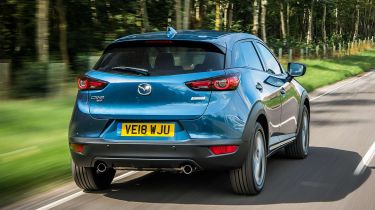Used Mazda CX-3 (Mk1, 2015-2020) review - How much will it cost?
It’s not the cheapest supermini-based SUV you can buy; diesel and four-wheel drive versions are rare
The Mazda CX-3 cost between £17,500 and nearly £25,000 when it went on sale in 2015, placing it somewhere between its mainstream and premium rivals. Cheaper options were and are available, but Mazda’s reputation for reliability and the CX-3’s upmarket interior combine to make it worth the outlay.
Prices
Prices have dropped to around £10,000 for an early Mazda CX-3, rising to around £22,500 for a 2020 example. Bank on spending at least £15,000 on a post-facelift CX-3
Some patience is required if you’re after a diesel or four-wheel drive CX-3 as sales were dominated by front-wheel drive cars with a petrol engine. As a result, you’ll need to find at least £12,000 for a four-wheel drive CX-3, although prices of diesel versions are roughly in line with the petrol models.
You can check out the latest used prices for the Mazda CX-3 on our sister site BuyaCar.
Economy and CO2 emissions
The claimed economy of the 1.8 SkyActiv-D diesel is a lot poorer than the old 1.5 motor, but that's because of the new WLTP fuel economy test procedure. Mazda claims 54.3mpg combined, but you're more likely to achieve that figure in the real world when compared to the 70.6mpg claims of the old NEDC-tested 1.5. Emissions are 114g/km, which is 9g/km more than the 1.5, so company car costs won't be drastically different.
Used - available now

2024 Audi
A3 Saloon
11,848 milesAutomaticPetrol1.5L
Cash £23,000
2019 Mercedes
GLC
53,377 milesAutomaticDiesel2.1L
Cash £18,987
2022 Nissan
Leaf
23,640 milesAutomaticElectric
Cash £10,300
2022 Peugeot
E-2008
53,032 milesAutomaticElectric
Cash £12,787With the demand for diesel fading, Mazda dropped the option of an auto box and four-wheel drive.
The 2.0-litre petrol model is well worth considering. It’s thirstier, but with Mazda claiming an official figure of 42.87mpg for the lower powered model and 38.2mpg for the more powerful 4WD model, these figures are more easily achieved than ever before. Adding an auto to the 118bhp model sees economy down to 39.2mpg, while the AWD auto has a claimed return of 34.9mpg. 2WD cars have a 48-litre fuel tank, but the more powerful petrol has a 44-litre fuel tank, as it has to make room for the 4WD running gear.
Emissions for the petrol models start at 140g/km for the 2WD auto, then 141g/km for the 2WD manual, 152g/k for the AWD auto, and 160g/km for the AWD manual.
Running costs
A service is required every 12 months or 12,500 miles. The first four checks cost £213, £389, £260 and £389 for petrol cars; for diesels it’s £281, £419, £378 and £444.
All engines are chain driven, so there are no timing belts to replace, but coolant needs renewing every 10 years/125,000 miles for £100. Brake fluid is required every two years (£95), as is an air-con service (£90). Dealer payment plans are available, although only to cover the first three years or 37,500 miles.
The Mazda CX-3 will never be an expensive car to insure. Look at the group ratings, and you'll see that SE models are in Group 18, but higher-spec SE-L cars start in Group 13. That's because SE-L cars and above include Mazda's city braking system, which means they will be less likely to be involved in a front-end collision. And because it also has this system, the top-spec Sport Nav has the same Group 18 rating as the SE version.
Our experts estimate that the CX-3 will hold on to its price reasonably well, although it has weaker figures than models such as the Audi Q2 and Mercedes GLA. It’s predicted to retain 45-50 per cent of its original value after three years.







